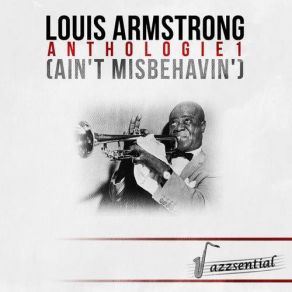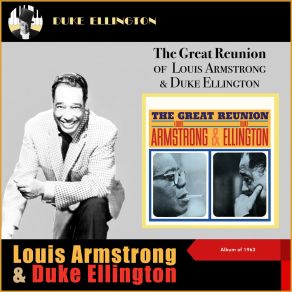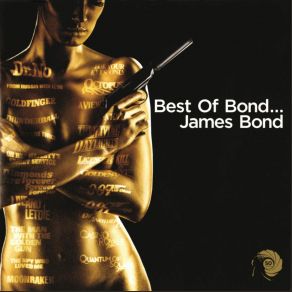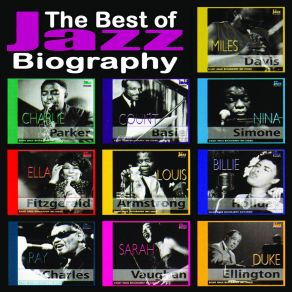Louis Armstrong
Wikimp3 information about the music of Louis Armstrong. On our website we have 70 albums and 70 collections of artist Louis Armstrong. You can find useful information and download songs of this artist. We also know that Louis Armstrong represents Jazz genres.
Biography
[Edit]Louis Armstrong was the first important soloist to emerge in jazz, and he became the most influential musician in the music's history. As a trumpet virtuoso, his playing, beginning with the 1920s studio recordings made with his Hot Five and Hot Seven ensembles, charted a future for jazz in highly imaginative, emotionally charged improvisation. For this, he is revered by jazz fans. But Armstrong also became an enduring figure in popular music, due to his distinctively phrased bass singing and engaging personality, which were on display in a series of vocal recordings and film roles.
Armstrong had a difficult childhood. William Armstrong, his father, was a factory worker who abandoned the family soon after the boy's birth. Armstrong was brought up by his mother, Mary (Albert) Armstrong, and his maternal grandmother. He showed an early interest in music, and a junk dealer for whom he worked as a grade-school student helped him buy a cornet, which he taught himself to play. He dropped out of school at 11 to join an informal group, but on December 31, 1912, he fired a gun during a New Year's Eve celebration, for which he was sent to reform school. He studied music there and played cornet and bugle in the school band, eventually becoming its leader. He was released on June 16, 1914, and did manual labor while trying to establish himself as a musician. He was taken under the wing of cornetist Joe "King" Oliver, and when Oliver moved to Chicago in June 1918, he replaced him in the Kid Ory Band. He moved to the Fate Marable band in the spring of 1919, staying with Marable until the fall of 1921.
Armstrong moved to Chicago to join Oliver's band in August 1922 and made his first recordings as a member of the group in the spring of 1923. He married Lillian Harden, the pianist in the Oliver band, on February 5, 1924. (She was the second of his four wives.) On her encouragement, he left Oliver and joined Fletcher Henderson's band in New York, staying for a year and then going back to Chicago in November 1925 to join the Dreamland Syncopators, his wife's group. During this period, he switched from cornet to trumpet.
Armstrong had gained sufficient individual notice to make his recording debut as a leader on November 12, 1925. Contracted to OKeh Records, he began to make a series of recordings with studio-only groups called the Hot Fives or the Hot Sevens. For live dates, he appeared with the orchestras led by Erskine Tate and Carroll Dickerson. The Hot Fives' recording of "Muskrat Ramble" gave Armstrong a Top Ten hit in July 1926, the band for the track featuring Kid Ory on trombone, Johnny Dodds on clarinet, Lillian Harden Armstrong on piano, and Johnny St. Cyr on banjo.
By February 1927, Armstrong was well-enough known to front his own group, Louis Armstrong & His Stompers, at the Sunset Café in Chicago. (Armstrong did not function as a bandleader in the usual sense, but instead typically lent his name to established groups.) In April, he reached the charts with his first vocal recording, "Big Butter and Egg Man," a duet with May Alix. He took a position as star soloist in Carroll Dickerson's band at the Savoy Ballroom in Chicago in March 1928, later taking over as the band's frontman. "Hotter than That" was in the Top Ten in May 1928, followed in September by "West End Blues," which later became one of the first recordings named to the Grammy Hall of Fame.
Armstrong returned to New York with his band for an engagement at Connie's Inn in Harlem in May 1929. He also began appearing in the orchestra of Hot Chocolates, a Broadway revue, given a featured spot singing "Ain't Misbehavin'." In September, his recording of the song entered the charts, becoming a Top Ten hit.
Armstrong fronted the Luis Russell Orchestra for a tour of the South in February 1930, then in May went to Los Angeles, where he led a band at Sebastian's Cotton Club for the next ten months. He made his film debut in Ex-Flame, released at the end of 1931. By the start of 1932, he had switched from the "race"-oriented OKeh label to its pop-oriented big sister Columbia Records, for which he recorded two Top Five hits, "Chinatown, My Chinatown" and "You Can Depend on Me" before scoring a number one hit with "All of Me" in March 1932; another Top Five hit, "Love, You Funny Thing," hit the charts the same month. He returned to Chicago in the spring of 1932 to front a band led by Zilner Randolph; the group toured around the country. In July, Armstrong sailed to England for a tour. He spent the next several years in Europe, his American career maintained by a series of archival recordings, including the Top Ten hits "Sweethearts on Parade" (August 1932; recorded December 1930) and "Body and Soul" (October 1932; recorded October 1930). His Top Ten version of "Hobo, You Can't Ride This Train," in the charts in early 1933, was on Victor Records; when he returned to the U.S. in 1935, he signed to recently formed Decca Records and quickly scored a double-sided Top Ten hit, "I'm in the Mood for Love"/"You Are My Lucky Star."
Armstrong's new manager, Joe Glaser, organized a big band for him that had its premiere in Indianapolis on July 1, 1935; for the next several years, he toured regularly. He also took a series of small parts in motion pictures, beginning with Pennies From Heaven in December 1936, and he continued to record for Decca, resulting in the Top Ten hits "Public Melody Number One" (August 1937), "When the Saints Go Marching in" (April 1939), and "You Won't Be Satisfied (Until You Break My Heart)" (April 1946), the last a duet with Ella Fitzgerald. He returned to Broadway in the short-lived musical Swingin' the Dream in November 1939.
With the decline of swing music in the post-World War II years, Armstrong broke up his big band and put together a small group dubbed the All Stars, which made its debut in Los Angeles on August 13, 1947. He embarked on his first European tour since 1935 in February 1948, and thereafter toured regularly around the world. In June 1951 he reached the Top Ten of the LP charts with Satchmo at Symphony Hall ("Satchmo" being his nickname), and he scored his first Top Ten single in five years with "(When We Are Dancing) I Get Ideas" later in the year. The single's B-side, and also a chart entry, was "A Kiss to Build a Dream On," sung by Armstrong in the film The Strip. In 1993, it gained renewed popularity when it was used in the film Sleepless in Seattle.
Armstrong completed his contract with Decca in 1954, after which his manager made the unusual decision not to sign him to another exclusive contract but instead to have him freelance for different labels. Satch Plays Fats, a tribute to Fats Waller, became a Top Ten LP for Columbia in October 1955, and Verve Records contracted Armstrong for a series of recordings with Ella Fitzgerald, beginning with the chart LP Ella and Louis in 1956.
Armstrong continued to tour extensively, despite a heart attack in June 1959. In 1964, he scored a surprise hit with his recording of the title song from the Broadway musical Hello, Dolly!, which reached number one in May, followed by a gold-selling album of the same name. It won him a Grammy for best vocal performance. This pop success was repeated internationally four years later with "What a Wonderful World," which hit number one in the U.K. in April 1968. It did not gain as much notice in the U.S. until 1987 when it was used in the film Good Morning, Vietnam, after which it became a Top 40 hit. Armstrong was featured in the 1969 film of Hello, Dolly!, performing the title song as a duet with Barbra Streisand. He performed less frequently in the late '60s and early '70s, and died of a heart ailment in 1971 at the age of 69.
As an artist, Armstrong was embraced by two distinctly different audiences: jazz fans who revered him for his early innovations as an instrumentalist, but were occasionally embarrassed by his lack of interest in later developments in jazz and, especially, by his willingness to serve as a light entertainer; and pop fans, who delighted in his joyous performances, particularly as a vocalist, but were largely unaware of his significance as a jazz musician. Given his popularity, his long career, and the extensive label-jumping he did in his later years, as well as the differing jazz and pop sides of his work, his recordings are extensive and diverse, with parts of his catalog owned by many different companies. But many of his recorded performances are masterpieces, and none are less than entertaining.
Title: The Universal Masters Collection: Classic, Louis Armstrong
Artist: Louis Armstrong
Genre: Jazz
Title: Bing and Satchmo (with Bing Crosby) [Bonus Track Version]
Artist: Louis Armstrong
Genre: Jazz
Title: Complete Louis Armstrong " The King Of The Zulus ", 1948-1949, Vol. 15 (CD1)
Artist: Louis Armstrong
Genre: Jazz
Title: The Great American Songbook
Artist: Louis Armstrong, Louis Armstrong Orchestra
Title: Louis And The Good Book + Louis And The Angels (Bonus Track Version)
Artist: Louis Armstrong
Genre: Jazz
Title: Satchmo At Symphony Hall (65th Anniversary) - The Complete Performances
Artist: His All Stars, Louis Armstrong
Genre: Jazz
Title: The Great Chicago Concert (Disc 2)
Artist: Louis Armstrong
Genre: Blues, Jazz, Blues Jazz, Pop, Theatre/Soundtrack
Title: The Complete Louis Armstrong and The Dukes of Dixieland (Bonus Track Version)
Artist: Louis Armstrong
Genre: Jazz
Title: Louis Armstrong Sings Back Through the Years / A Centennial Celebration
Artist: Louis Armstrong
Genre: Jazz, Vocal Jazz, Pop
Title: The Complete Decca Studio Master Takes 1940 - 1949 (Disc 2)
Artist: Louis Armstrong
Genre: Jazz
Title: The Complete Louis Armstrong And The Dukes Of Dixieland
Artist: Louis Armstrong, The Dukes Of Dixieland
Genre: Jazz
Title: 20th Century Masters: The Millennium Collection: Best Of Louis Armstrong
Artist: Louis Armstrong
Genre: Jazz
Title: The Great Reunion Of Louis Armstrong & Duke Ellington (Album Of 1963)
Artist: Louis Armstrong
Genre: Jazz
Title: Louie And The Dukes Of Dixieland
Artist: The Dukes Of Dixieland, Louis Armstrong
Genre: Jazz, Vocal Jazz
Title: Bing And Satchmo (Bonus Track Version)
Artist: Bing Crosby, Louis Armstrong
Genre: Jazz, Vocal Jazz
Title: The Complete Louis Armstrong-Duke Ellington Sessions
Artist: Louis Armstrong, Duke Ellington
Genre: Jazz
Title: The Complete Decca Studio Master Takes 1935 - 1939. Centennial Edition
Artist: Louis Armstrong
Genre: Jazz
Collections
Title: 15 Great Classics
Genre: Pop
Title: American Dinner
Genre: Theatre/Soundtrack
Title: Best of Bond...James Bond
Genre: Theatre/Soundtrack
Title: Cruisin' to the Hits of the '50s & '60s
Genre: Pop
Title: Christmas Remixed - Holiday Classics Re-Grooved
Genre: Electronica
Title: The Very Best of Cole Porter
Genre: Jazz, Vocal Jazz, Pop
Title: Traditional Christmas Classics
Genre:
Title: Chart Busters, Vol. 2
Genre: Rock
Title: The Jazz Wedding Album: First Dances
Genre: Jazz
Title: 100 Soul Hits
Genre: Rock
Title: 2012: Soundtrack To The End Of The World
Genre: Pop
Title: Number 1's: Christmas
Genre: Pop, Traditional Pop Music
Title: Blue Jasmine (Music from the Motion Picture)
Genre: Jazz, Theatre/Soundtrack
Title: The Buddha Greatest Lounge
Genre: Electronica
Title: A Jazzy Christmas Time
Genre: Jazz, Traditional Pop Music
Title: Ultimate Beatnik Collection, Vol. 2
Genre: Rock
Title: A Relaxing Jazz Christmas
Genre:
Title: Christmas Jazz Carols
Genre: Jazz
Title: Christmas Jazz
Genre: Traditional Pop Music
Title: Original Hits: Singers of All Times
Genre: Jazz
Title: Scats & All That Jazz
Genre: Jazz
Title: Legends of Jazz, Vol.1
Genre: Jazz
Title: The Best of Jazz Biography
Genre: Jazz
Title: Ultimate Jazz Ballads
Genre: Jazz
Title: Jazz Lounge
Genre: Jazz
Title: Blues - Essential Soul
Genre: Blues
Title: The 20 Most Essential Jazz Ballads
Genre: Jazz
Title: Top Hits of the 1930s
Genre: Rock
Title: Hark! The Herald Angels Swing: Christmas Jazz
Genre:
Title: Jazz - An American Road Trip
Genre: Jazz
Title: The Greatest Voices of Jazz
Genre: Jazz
Title: Essential Jazz Voices
Genre: Jazz
Title: The Darkest Pieces of Jazz
Genre: Jazz
Title: 1991 Vamp Internacional
Genre: Pop
Title: Happy New Year - Jazz
Genre: Jazz
Title: Jukebox Favourites - Best of Bar Jazz
Genre: Jazz
Title: Summer Movie Soundtracks
Genre: Theatre/Soundtrack
Title: Broadway: The American Musical
Genre: Theatre/Soundtrack
Title: Charleston All Night! The Very Best Of
Genre: Jazz
Title: Top 100 Classics - The Very Best of the 1930's, Vol. 2
Genre: Jazz
Title: Madagascar (Motion Picture Soundtrack)
Genre: Theatre/Soundtrack
Title: 100 Original Soundtracks, Hollywood Vol 1
Genre: Theatre/Soundtrack
Title: Top 100 Classics - The Very Best of the 1920's, Vol. 3
Genre: Jazz
Title: Top 100 Classics - The Very Best of the 1920's, Vol. 1
Genre: Pop
Title: Jukebox Favourites - Hits of the 20s & 30s
Genre: Pop
Title: Speakeasy Music of the 1920's
Genre: Jazz
Title: Top 100 Classics - The Very Best of the 1920's, Vol. 2
Genre: Jazz
Title: The 100 Best Songs Vintage Vocal Jazz
Genre: Jazz
Title: Evergreens - Those Good Old Songs - 2
Genre: Pop
Title: The Ultimate Christmas Party
Genre: Traditional Pop Music
Title: Modern Art of Christmas: All I Want for Christmas
Genre:
Featuring albums
Title: My Dream Duets
Artist: Barry Manilow
Genre: Jazz, Rock, Punk Rock, Pop, Classical, Easy Listening
Title: The Best of Ella Fitzgerald & Louis Armstrong
Artist: Ella Fitzgerald
Genre: Jazz, Vocal Jazz, Pop
Title: Ella and Louis
Artist: Ella Fitzgerald
Title: The Complete Ella Fitzgerald & Louis Armstrong On Verve
Artist: Ella Fitzgerald
Genre: Jazz, Vocal Jazz, Pop
Title: Ella: The Legendary Decca Recordings
Artist: Ella Fitzgerald
Genre: Jazz, Vocal Jazz, Pop, Bop
Title: The Complete Decca Recordings (US Release Box Set)
Artist: Billie Holiday
Genre: Blues, Jazz, Vocal Jazz, Pop
Title: Ultimate Kenny G
Artist: Kenny G
Genre: Jazz, Contemporary Jazz, Crossover Jazz, Rock, Pop, Smooth Jazz
Title: Louis Jordan: Let the Good Times Roll - The Anthology 1938-1953
Artist: Louis Jordan
Genre: Hip Hop/R&B, Soul, Blues, Jazz
Title: Bing: His Legendary Years 1931-1957 (Box Set)
Artist: Bing Crosby
Genre: Jazz, Vocal Jazz, Pop
Title: E' Natale (50 Canzoni Tradizionali di Natale)
Artist: Variuos Artists
Genre: Traditional Pop Music
Title: Driving Miss Daisy (Original Motion Picture Soundtrack)
Artist: Hans Zimmer
Genre: New Age, Rock, Pop, Alternative, Theatre/Soundtrack
Title: Best of Bond...James Bond 50th Anniversary Collection
Artist: Various Artists
Genre: Theatre/Soundtrack
Title: Best Of Bond...James Bond (50th Anniversary Collection)
Artist: Various Artists
Genre: Theatre/Soundtrack
Title: Irving Berlin Always
Artist: Irving Berlin Always
Genre: Blues, Jazz, Vocal Jazz, Rock, Pop, Theatre/Soundtrack, Bop, Smooth Jazz
Title: DJ Yoda's How to Cut and Paste: The Thirties Edition
Artist: DJ Yoda
Genre: Hip Hop/R&B, Rap, Jazz, Rock, New Wave, Dancefloor, Pop, Dance Pop, Alternative
Title: Stardust: The Hoagy Carmichael Songbook
Artist: Hoagy Carmichael
Genre: Jazz, Pop, Theatre/Soundtrack
Title: The Last Decca Years 1949-1954
Artist: Ella Fitzgerald
Genre: Blues, Jazz, Vocal Jazz, Pop, Bop
Title: Priceless Jazz Collection: Billie Holiday
Artist: Billie Holiday
Genre: Blues, Jazz, Vocal Jazz, Pop
Title: The Complete Commodore & Decca Masters
Artist: Billie Holiday
Genre: Blues, Jazz, Vocal Jazz, Rock, Pop
Title: At First Sight (Motion Picture Soundtrack)
Artist: Mark Isham
Genre: Jazz, Theatre/Soundtrack
Title: Forever Jazz: Greatest Hits, Vol. 3 (The Best Collection)
Artist: Vários Artistas / Varios Artistas
Genre: Jazz
Title: Forever Jazz: Greatest Hits, Vol. 2 (The Best Collection)
Artist: Vários Artistas / Varios Artistas
Genre: Jazz
Title: Smooth Jazz (New Stereo Recordings by the Original Artists)
Artist: Various Artists
Genre: Jazz
Title: Bert Stern: Original Mad Man (Music from the Film)
Artist: Starr Parodi
Genre: Jazz, Theatre/Soundtrack
Title: What Is Jazz
Artist: Leonard Bernstein
Genre: Jazz, Traditional Pop Music, Theatre/Soundtrack
















































































































































































































